Jianwen Xie
Video-MMLU: A Massive Multi-Discipline Lecture Understanding Benchmark
Apr 20, 2025Abstract:Recent advancements in language multimodal models (LMMs) for video have demonstrated their potential for understanding video content, yet the task of comprehending multi-discipline lectures remains largely unexplored. We introduce Video-MMLU, a massive benchmark designed to evaluate the capabilities of LMMs in understanding Multi-Discipline Lectures. We evaluate over 90 open-source and proprietary models, ranging from 0.5B to 40B parameters. Our results highlight the limitations of current models in addressing the cognitive challenges presented by these lectures, especially in tasks requiring both perception and reasoning. Additionally, we explore how the number of visual tokens and the large language models influence performance, offering insights into the interplay between multimodal perception and reasoning in lecture comprehension.
Scalable Language Models with Posterior Inference of Latent Thought Vectors
Feb 03, 2025Abstract:We propose a novel family of language models, Latent-Thought Language Models (LTMs), which incorporate explicit latent thought vectors that follow an explicit prior model in latent space. These latent thought vectors guide the autoregressive generation of ground tokens through a Transformer decoder. Training employs a dual-rate optimization process within the classical variational Bayes framework: fast learning of local variational parameters for the posterior distribution of latent vectors, and slow learning of global decoder parameters. Empirical studies reveal that LTMs possess additional scaling dimensions beyond traditional LLMs, yielding a structured design space. Higher sample efficiency can be achieved by increasing training compute per token, with further gains possible by trading model size for more inference steps. Designed based on these scaling properties, LTMs demonstrate superior sample and parameter efficiency compared to conventional autoregressive models and discrete diffusion models. They significantly outperform these counterparts in validation perplexity and zero-shot language modeling. Additionally, LTMs exhibit emergent few-shot in-context reasoning capabilities that scale with model and latent size, and achieve competitive performance in conditional and unconditional text generation.
Latent Space Energy-based Neural ODEs
Sep 05, 2024


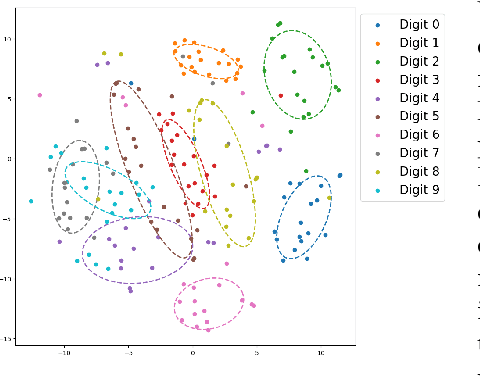
Abstract:This paper introduces a novel family of deep dynamical models designed to represent continuous-time sequence data. This family of models generates each data point in the time series by a neural emission model, which is a non-linear transformation of a latent state vector. The trajectory of the latent states is implicitly described by a neural ordinary differential equation (ODE), with the initial state following an informative prior distribution parameterized by an energy-based model. Furthermore, we can extend this model to disentangle dynamic states from underlying static factors of variation, represented as time-invariant variables in the latent space. We train the model using maximum likelihood estimation with Markov chain Monte Carlo (MCMC) in an end-to-end manner, without requiring additional assisting components such as an inference network. Our experiments on oscillating systems, videos and real-world state sequences (MuJoCo) illustrate that ODEs with the learnable energy-based prior outperform existing counterparts, and can generalize to new dynamic parameterization, enabling long-horizon predictions.
Latent Energy-Based Odyssey: Black-Box Optimization via Expanded Exploration in the Energy-Based Latent Space
May 27, 2024Abstract:Offline Black-Box Optimization (BBO) aims at optimizing a black-box function using the knowledge from a pre-collected offline dataset of function values and corresponding input designs. However, the high-dimensional and highly-multimodal input design space of black-box function pose inherent challenges for most existing methods that model and operate directly upon input designs. These issues include but are not limited to high sample complexity, which relates to inaccurate approximation of black-box function; and insufficient coverage and exploration of input design modes, which leads to suboptimal proposal of new input designs. In this work, we consider finding a latent space that serves as a compressed yet accurate representation of the design-value joint space, enabling effective latent exploration of high-value input design modes. To this end, we formulate an learnable energy-based latent space, and propose Noise-intensified Telescoping density-Ratio Estimation (NTRE) scheme for variational learning of an accurate latent space model without costly Markov Chain Monte Carlo. The optimization process is then exploration of high-value designs guided by the learned energy-based model in the latent space, formulated as gradient-based sampling from a latent-variable-parameterized inverse model. We show that our particular parameterization encourages expanded exploration around high-value design modes, motivated by inversion thinking of a fundamental result of conditional covariance matrix typically used for variance reduction. We observe that our method, backed by an accurately learned informative latent space and an expanding-exploration model design, yields significant improvements over strong previous methods on both synthetic and real world datasets such as the design-bench suite.
Dual-Space Optimization: Improved Molecule Sequence Design by Latent Prompt Transformer
Feb 27, 2024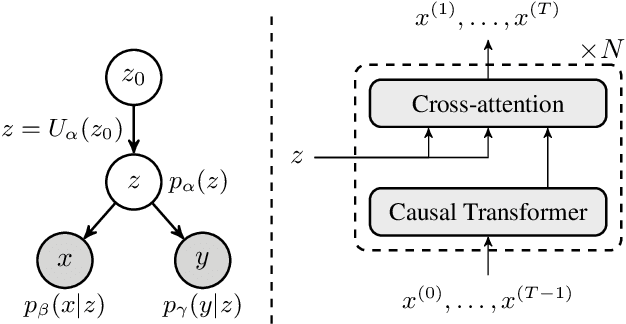
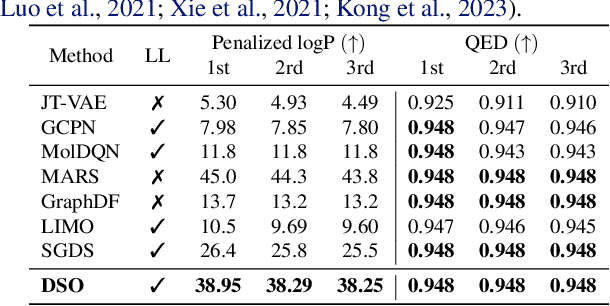
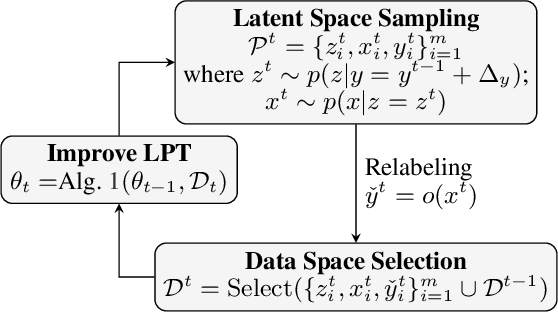
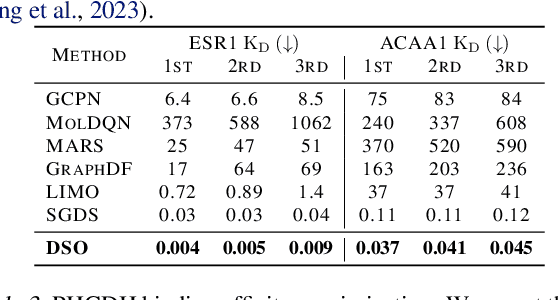
Abstract:Designing molecules with desirable properties, such as drug-likeliness and high binding affinities towards protein targets, is a challenging problem. In this paper, we propose the Dual-Space Optimization (DSO) method that integrates latent space sampling and data space selection to solve this problem. DSO iteratively updates a latent space generative model and a synthetic dataset in an optimization process that gradually shifts the generative model and the synthetic data towards regions of desired property values. Our generative model takes the form of a Latent Prompt Transformer (LPT) where the latent vector serves as the prompt of a causal transformer. Our extensive experiments demonstrate effectiveness of the proposed method, which sets new performance benchmarks across single-objective, multi-objective and constrained molecule design tasks.
Latent Plan Transformer: Planning as Latent Variable Inference
Feb 07, 2024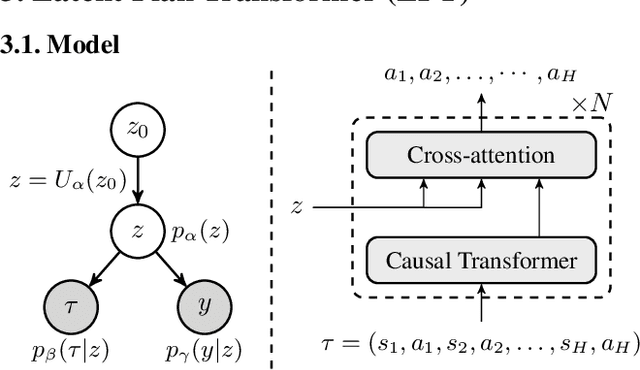


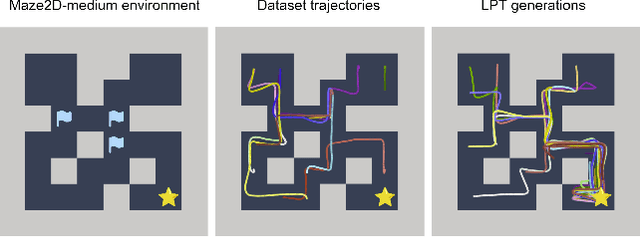
Abstract:In tasks aiming for long-term returns, planning becomes necessary. We study generative modeling for planning with datasets repurposed from offline reinforcement learning. Specifically, we identify temporal consistency in the absence of step-wise rewards as one key technical challenge. We introduce the Latent Plan Transformer (LPT), a novel model that leverages a latent space to connect a Transformer-based trajectory generator and the final return. LPT can be learned with maximum likelihood estimation on trajectory-return pairs. In learning, posterior sampling of the latent variable naturally gathers sub-trajectories to form a consistent abstraction despite the finite context. During test time, the latent variable is inferred from an expected return before policy execution, realizing the idea of planning as inference. It then guides the autoregressive policy throughout the episode, functioning as a plan. Our experiments demonstrate that LPT can discover improved decisions from suboptimal trajectories. It achieves competitive performance across several benchmarks, including Gym-Mujoco, Maze2D, and Connect Four, exhibiting capabilities of nuanced credit assignments, trajectory stitching, and adaptation to environmental contingencies. These results validate that latent variable inference can be a strong alternative to step-wise reward prompting.
STANLEY: Stochastic Gradient Anisotropic Langevin Dynamics for Learning Energy-Based Models
Oct 19, 2023Abstract:We propose in this paper, STANLEY, a STochastic gradient ANisotropic LangEvin dYnamics, for sampling high dimensional data. With the growing efficacy and potential of Energy-Based modeling, also known as non-normalized probabilistic modeling, for modeling a generative process of different natures of high dimensional data observations, we present an end-to-end learning algorithm for Energy-Based models (EBM) with the purpose of improving the quality of the resulting sampled data points. While the unknown normalizing constant of EBMs makes the training procedure intractable, resorting to Markov Chain Monte Carlo (MCMC) is in general a viable option. Realizing what MCMC entails for the EBM training, we propose in this paper, a novel high dimensional sampling method, based on an anisotropic stepsize and a gradient-informed covariance matrix, embedded into a discretized Langevin diffusion. We motivate the necessity for an anisotropic update of the negative samples in the Markov Chain by the nonlinearity of the backbone of the EBM, here a Convolutional Neural Network. Our resulting method, namely STANLEY, is an optimization algorithm for training Energy-Based models via our newly introduced MCMC method. We provide a theoretical understanding of our sampling scheme by proving that the sampler leads to a geometrically uniformly ergodic Markov Chain. Several image generation experiments are provided in our paper to show the effectiveness of our method.
Molecule Design by Latent Prompt Transformer
Oct 05, 2023Abstract:This paper proposes a latent prompt Transformer model for solving challenging optimization problems such as molecule design, where the goal is to find molecules with optimal values of a target chemical or biological property that can be computed by an existing software. Our proposed model consists of three components. (1) A latent vector whose prior distribution is modeled by a Unet transformation of a Gaussian white noise vector. (2) A molecule generation model that generates the string-based representation of molecule conditional on the latent vector in (1). We adopt the causal Transformer model that takes the latent vector in (1) as prompt. (3) A property prediction model that predicts the value of the target property of a molecule based on a non-linear regression on the latent vector in (1). We call the proposed model the latent prompt Transformer model. After initial training of the model on existing molecules and their property values, we then gradually shift the model distribution towards the region that supports desired values of the target property for the purpose of molecule design. Our experiments show that our proposed model achieves state of the art performances on several benchmark molecule design tasks.
Learning Energy-Based Models by Cooperative Diffusion Recovery Likelihood
Sep 12, 2023Abstract:Training energy-based models (EBMs) with maximum likelihood estimation on high-dimensional data can be both challenging and time-consuming. As a result, there a noticeable gap in sample quality between EBMs and other generative frameworks like GANs and diffusion models. To close this gap, inspired by the recent efforts of learning EBMs by maximimizing diffusion recovery likelihood (DRL), we propose cooperative diffusion recovery likelihood (CDRL), an effective approach to tractably learn and sample from a series of EBMs defined on increasingly noisy versons of a dataset, paired with an initializer model for each EBM. At each noise level, the initializer model learns to amortize the sampling process of the EBM, and the two models are jointly estimated within a cooperative training framework. Samples from the initializer serve as starting points that are refined by a few sampling steps from the EBM. With the refined samples, the EBM is optimized by maximizing recovery likelihood, while the initializer is optimized by learning from the difference between the refined samples and the initial samples. We develop a new noise schedule and a variance reduction technique to further improve the sample quality. Combining these advances, we significantly boost the FID scores compared to existing EBM methods on CIFAR-10 and ImageNet 32x32, with a 2x speedup over DRL. In addition, we extend our method to compositional generation and image inpainting tasks, and showcase the compatibility of CDRL with classifier-free guidance for conditional generation, achieving similar trade-offs between sample quality and sample diversity as in diffusion models.
Progressive Energy-Based Cooperative Learning for Multi-Domain Image-to-Image Translation
Jun 26, 2023Abstract:This paper studies a novel energy-based cooperative learning framework for multi-domain image-to-image translation. The framework consists of four components: descriptor, translator, style encoder, and style generator. The descriptor is a multi-head energy-based model that represents a multi-domain image distribution. The components of translator, style encoder, and style generator constitute a diversified image generator. Specifically, given an input image from a source domain, the translator turns it into a stylised output image of the target domain according to a style code, which can be inferred by the style encoder from a reference image or produced by the style generator from a random noise. Since the style generator is represented as an domain-specific distribution of style codes, the translator can provide a one-to-many transformation (i.e., diversified generation) between source domain and target domain. To train our framework, we propose a likelihood-based multi-domain cooperative learning algorithm to jointly train the multi-domain descriptor and the diversified image generator (including translator, style encoder, and style generator modules) via multi-domain MCMC teaching, in which the descriptor guides the diversified image generator to shift its probability density toward the data distribution, while the diversified image generator uses its randomly translated images to initialize the descriptor's Langevin dynamics process for efficient sampling.
 Add to Chrome
Add to Chrome Add to Firefox
Add to Firefox Add to Edge
Add to Edge